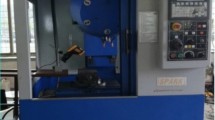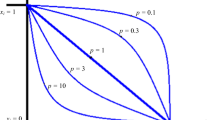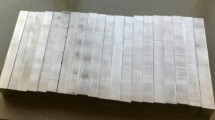Abstract
In this research study, empirical mathematical models for cutting forces and surface roughness have been developed to investigate the effect of axial depth of cut, feed, radial depth of cut and cutting speed in high-speed ball-end milling of Al2014-T6. Ball-end milling experiments have been planned using central composite design based on response surface methodology. The mathematical models have been established and tested for adequacy. A full quadratic model has been adopted for modelling. It has been found that axial depth of cut is the most dominant cutting parameter for the tangential and axial cutting forces, accounting for 49.38 and 47.12% contributions, respectively. Radial depth of cut is the most dominant parameter for radial force and contributes 69.94% for it. Results also revealed that force components decrease with increase in cutting speed. There is very small variation in cutting force components in the cutting speed range of 75–150 m/min at lower values of axial and radial depth of cut. Surface roughness is effected by cutting speed largely followed by feed. Multi-objective optimization has been performed using composite desirability to optimize the cutting parameters for minimum surface roughness and cutting forces simultaneously. Confirmation tests have been conducted using optimal set of cutting parameters. The results of confirmation tests are very close to the predicted results.













Similar content being viewed by others
References
Wan M, Altintas Y (2014) Mechanics and dynamics of thread milling process. Int J Mach Tools Manuf 87:16–26. doi:10.1016/j.ijmachtools.2014.07.006
Abukhshim NA, Mativenga PT, Sheikh MA (2006) Heat generation and temperature prediction in metal cutting: a review and implication for high speed machining. Int J Mach Tools Manuf 46:782–800. doi:10.1016/j.ijmachtools.2005.07.024
Axinte D, Dewes RC (2010) High-speed milling of AISI H13 hot-work tool steel using polycrystalline cubic boron nitride ball-nose mills: from experimental investigations and empirical modelling to functional testing of the machined surfaces. Proc Inst Mech Eng Part B J Eng Manuf 224(1):15–24. doi:10.1243/09544054JEM1630
Kitagwa T, Kubo A, Maekawa K (1997) Temperature and wear of cutting tools in high-speed machining of Inconel 718 and Ti–6A1–6V–2Sn. Wear 202:142–148. doi:10.1016/S0043-1648(96)07255-9
Alauddin M, El Baradie MA, Hashmi MSJ (1996) Modelling of cutting force in end milling Inconel 718. J Mater Proc Technol 58(1):100–108. doi:10.1016/0924-0136(95)02113-2
Ding T, Zhang S, Wang Y, Zhu X (2010) Empirical model and optimal cutting parameters for cutting forces and surface roughness in hard milling of AISI H13 steel. Int J Adv Manuf Technol 51(1):45–55. doi:10.1007/s00170-010-2598-2
Ozel T, Hsu TK, Zeren E (2005) Effects of cutting edge geometry, workpiece hardness, feed rate and cutting speed on surface roughness and forces in finish turning of hardened AISI H13 steel. Int J Adv Manuf Technol 25(3):262–269. doi:10.1007/s00170-003-1878-5
Dikshit MK, Puri AB, Maity A (2014) Experimental study of cutting forces in ball end milling of Al2014-T6 using response surface methodology. Procedia Mater Sci 6:612–622. doi:10.1016/j.mspro.2014.07.076
Subramanian M, Sakthivel M, Sooryaprakash K, Sudhakaran R (2013) Optimization of cutting parameters for cutting force in shoulder milling of Al7075-T6 using response surface methodology and genetic algorithm. Procedia Eng 64:690–700. doi:10.1016/j.proeng.2013.09.144
Yang Y-K, Chuang M-T, Lin S-S (2009) Optimization of dry machining parameters for high-purity graphite in end milling process via design of experiments methods. J Mater Process Technol 209:4395–4400. doi:10.1016/j.imatprotec.2008.11.021
Alagumurthi N, Palaniradja K, Soundararajan V (2006) Optimization of grinding process through design of experiment (DOE)—a comparative study. Mater Manuf Process 21(1):19–21. doi:10.1080/AMP-200060605
Toh CK (2004) Static and dynamic cutting force analysis when high speed rough milling hardened steel. Mater Des 25(1):41–50. doi:10.1016/S0261-3069(03)00160-2
Tangjitsitcharoen S, Thesniyom P, Ratanakuakangwan S (2014) Prediction of surface roughness in ball-end milling process by utilizing dynamic cutting force ratio. J Intell Manuf. doi:10.1007/s10845-014-0958-8
Sriyotha P, Sahasrabudhe A, Yamazaki K, Mori M (2006) Geometrical modelling of ball end finish milling process for a surface finish. Proc Inst Mech Eng Part B J Eng Manuf 220:467–477. doi:10.1243/09544054JEM228
Liu N, Loftus M (2006) Prediction of surface quality from ball-nose milling in high speed machining applications. Proc Inst Mech Eng Part B J Eng Manuf 220:571–578. doi:10.1243/095440505X32472
Fuh KH, Wu CF (1995) A proposed statistical model for surface quality prediction in end-milling of Al alloy. Int J Mach Tools Manuf 35(8):1187–1200. doi:10.1016/0890-6955(95)90408-E
Alauddin M, El Baradie MA, Hashmi MSJ (1995) Computer-aided analysis of a surface-roughness model for end milling. J Mater Process Technol 55:123–127. doi:10.1016/0924-0136(95)01795-X
Monsour M, Abdalla H (2002) Surface roughness model for end milling: a semi-free cutting carbon casehardening steel (EN32) in dry condition. J Mater Process Technol 124:183–191. doi:10.1016/S0924-0136(02)00135-8
Vivancos J, Luis CJ, Costa L, Ortiz JA (2004) Optimal machining parameters selection in high speed milling of hardened steels for injection moulds. J Mater Process Technol 155–156:1505–1512. doi:10.1016/j.jmatprotec.2004.04.260
Dikshit MK, Puri FAB, Maity A (2016) Optimization of surface roughness in ball-end milling using teaching-learning-based optimization and response surface methodology. Proc Inst Mech Eng Part B J Eng Manuf. doi:10.1177/0954405416634266
Batista MF, Rodrigues AR, Coelho RT (2015) Modelling and characterisation of roughness of moulds produced by high-speed machining with ball nose end mill. Proc Inst Mech Eng Part B J Eng Manuf. doi:10.1177/0954405415584898
Bhardwaj B, Kumar R, Singh PK (2014) Effect of machining parameters on surface roughness in end milling of AISI 1019 steel. Proc Inst Mech Eng Part B J Eng Manuf 228(5):704–714. doi:10.1177/0954405413506417
Malghan RL, Rao KMC, Shettigar AK, Rao SS, D’Souza RJ (2016) Application of particle swarm optimization and response surface methodology for machining parameters optimization of aluminium matrix composites in milling operation. J Braz Soc Mech Sci Eng. doi:10.1007/s40430-016-0675-7
Mayers RH, Montgomery DC (2002) Response surface methodology-process and product optimization using designed experiments, 2nd edn. Wiley-Interscience, New York
Montgomery DC (1997) Design and analysis of experiments, 4th edn. Wiley, New York
Puri AB, Banerjee S (2013) Multiple-response optimisation of electrochemical grinding characteristics through response surface methodology. Int J Adv Manuf Technol 64(5):715–725. doi:10.1007/s00170-012-4065-8
Derringer GC, Suich R (1980) Simultaneous optimization of several response variables. J Qual Technol 12:214–219
Acknowledgements
The experimental work was carried out using Vertical Milling Center in Manufacturing Technology Laboratory, CSIR-CMERI Durgapur, India. The authors acknowledge the support extended by Mr. S.Y. Pujar for his assistance in conducting experiments.
Author information
Authors and Affiliations
Corresponding author
Additional information
Technical Editor: Márcio Bacci da Silva.
Rights and permissions
About this article
Cite this article
Dikshit, M.K., Puri, A.B. & Maity, A. Modelling and application of response surface optimization to optimize cutting parameters for minimizing cutting forces and surface roughness in high-speed, ball-end milling of Al2014-T6. J Braz. Soc. Mech. Sci. Eng. 39, 5117–5133 (2017). https://doi.org/10.1007/s40430-017-0865-y
Received:
Accepted:
Published:
Issue Date:
DOI: https://doi.org/10.1007/s40430-017-0865-y




